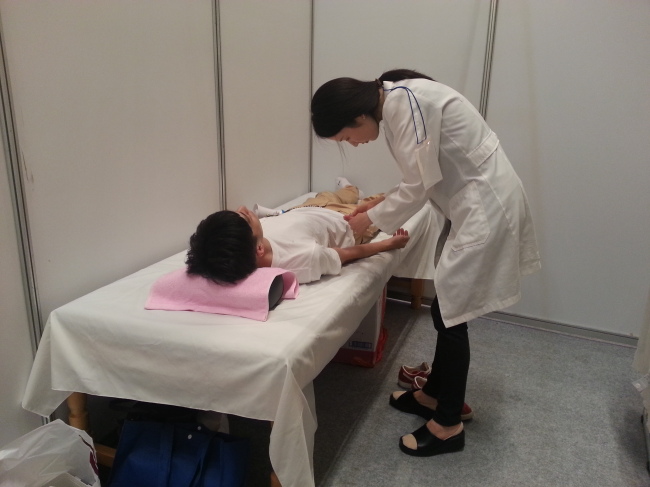Traditional Korean medicine industry struggles to expand
Dermatologists criticize traditional doctors’ cosmetic treatment as ‘invasion of expertise’
By Claire LeePublished : July 17, 2014 - 20:54
For many years in the past, Koreans would seek doctors of traditional Korean medicine for herbal medicine to boost their energy levels, or to get acupuncture treatment for chronic muscle pain.
The industry, however, has been struggling to expand its business into the field of dermatology and fertility medicine. Many clinics have been offering cosmetic treatments for conditions such as wrinkles and acne.
“We hope to overcome this perception that traditional Korean medicine is old and not scientific,” said Kim So-hyung, vice president of Seoul Korean Medicine Association.
“We hope to persuade the public that traditional medicine can be a great alternative option for even cosmetic treatments, and that it can also be as scientific as Western medicine.”
However, the move has been criticized by dermatologists, who argue that the doctors of traditional Korean medicine are only trying to make extra money by invading their areas of expertise.
Most recently, Hamsoa Oriental Clinic, one of the biggest traditional Korean medicine clinics in the country, developed new technology by combining traditional acupuncture with Fraxel fractional laser treatment, a technique for facial rejuvenation, and submitted a request to the Ministry of Food and Drug Safety for approval.
The industry, however, has been struggling to expand its business into the field of dermatology and fertility medicine. Many clinics have been offering cosmetic treatments for conditions such as wrinkles and acne.
“We hope to overcome this perception that traditional Korean medicine is old and not scientific,” said Kim So-hyung, vice president of Seoul Korean Medicine Association.
“We hope to persuade the public that traditional medicine can be a great alternative option for even cosmetic treatments, and that it can also be as scientific as Western medicine.”
However, the move has been criticized by dermatologists, who argue that the doctors of traditional Korean medicine are only trying to make extra money by invading their areas of expertise.
Most recently, Hamsoa Oriental Clinic, one of the biggest traditional Korean medicine clinics in the country, developed new technology by combining traditional acupuncture with Fraxel fractional laser treatment, a technique for facial rejuvenation, and submitted a request to the Ministry of Food and Drug Safety for approval.

“It is unethical for doctors to think they can expand their areas of medical practice simply by developing a machine (without research and training) or a technology,” said the Association of Korean Dermatologists in a statement earlier this month.
However, the problem may be linked with the current law.
In South Korea, medical doctors and doctors of traditional Korean medicine are allowed to give cosmetic treatments, including Botox injections and laser treatments for skin rejuvenation, even if they did not specialize in dermatology at medical school.
Aside from traditional medicine clinics, dental and otolaryngology clinics also offer cosmetic treatments, mostly Botox injections and nose fillers, aside from treatments for cavities or nasal congestion.
The Korea Medical Association, a major representative body of 100,000 physicians in the country, in fact runs a separate team that only deals with conflicts between medical doctors and doctors of traditional Korean medicine.
In May, the Seoul Korean Medicine Association held a research forum in Seoul, in which one of its members introduced the “micro needle therapy system.” He named the treatment, which uses a round roller inlaid with tiny needles thinner than human hair, a “traditional Korean” technology, as it uses needles ― the tool for acupuncture.
The treatment involves massaging the face with the roller, which, according to the Korean medicine doctor, stimulates collagen production and eventually revitalizes the skin.
The first such roller was developed in Germany, according to the Korean Dermatological Association. The product was called “dermaroller” and was first imported to South Korea in 2005. The device has been around as a non-Oriental beauty product available for sale overseas.
In fact, the Hong Kong Consumer Council issued a warning to users of the roller in 2011, announcing that using the device on one’s own, instead of getting the treatment from a certified medical professional, may result in infection by dangerous bacteria and viruses. Dermatology clinics in Korea also offer treatments using the “MTS” technology.
“When you use needles, it is acupuncture,” Kil Moon-soo, who is in charge of scholarly activities at Seoul Korean Medicine Association, told The Korea Herald. “We think it is a traditional Korean treatment. But it is dangerous for people to use the device on their own.”
By Claire Lee (dyc@heraldcorp.com)








![[Graphic News] More Koreans say they plan long-distance trips this year](http://res.heraldm.com/phpwas/restmb_idxmake.php?idx=644&simg=/content/image/2024/04/17/20240417050828_0.gif&u=)
![[KH Explains] Hyundai's full hybrid edge to pay off amid slow transition to pure EVs](http://res.heraldm.com/phpwas/restmb_idxmake.php?idx=644&simg=/content/image/2024/04/18/20240418050645_0.jpg&u=20240419100350)





![[From the Scene] Monks, Buddhists hail return of remains of Buddhas](http://res.heraldm.com/phpwas/restmb_idxmake.php?idx=652&simg=/content/image/2024/04/19/20240419050617_0.jpg&u=20240419175937)

![[KH Explains] Hyundai's full hybrid edge to pay off amid slow transition to pure EVs](http://res.heraldm.com/phpwas/restmb_idxmake.php?idx=652&simg=/content/image/2024/04/18/20240418050645_0.jpg&u=20240419100350)

![[Today’s K-pop] Illit drops debut single remix](http://res.heraldm.com/phpwas/restmb_idxmake.php?idx=642&simg=/content/image/2024/04/19/20240419050612_0.jpg&u=)